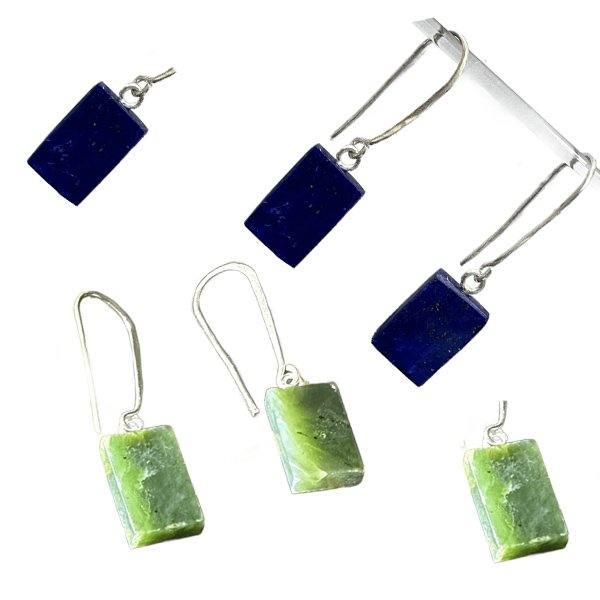
Exploring Lapis Lazuli: A Gemstone with a Ric ..
Apr 27 - 2024

Handmade gemstone
jewelry has captured the hearts of many in recent years, drawing admiration for
its exquisite craftsmanship and profound connection to nature. Whether it's a
delicate pendant adorned with a gem, a bold statement ring showcasing vibrant
hues, or a pair of earrings reflecting the elegance of nature, these creations
are more than mere accessories, they are timeless treasures imbued with
artistry and soul.
The allure of
handmade gemstone jewelry lies not only in its aesthetic appeal but the finest
gemstones shaping and then the metal settings, artisans pour their heart and
soul into crafting jewelry that exudes both elegance and individuality.
Moreover, handmade
gemstone jewelry offers a meaningful alternative to mainstream fashion,
allowing individuals to express their personal style while supporting artisanal
traditions. By choosing handmade pieces, wearers not only adorn themselves with
beauty but also contribute to the preservation of age-old techniques and the
livelihoods of artisans around the world.
As the demand and
love for handmade gemstone jewelry continues to captivate enthusiasts
worldwide, it serves as a reminder of the timeless appeal of craftsmanship and
the enduring bond between humanity and the treasures of the earth. Here are
some history and example of a few gemstones along with their metaphysical properties.
Lapis
Lazuli:
Lapis Lazuli, with
its deep blue color flecked with golden pyrite inclusions, has a rich history
dating back thousands of years. It was highly prized by ancient civilizations
for its vivid hue and mystical properties.
The earliest known
uses of Lapis Lazuli date back to around 6,000 years ago in the ancient
civilizations of Mesopotamia, Egypt, and the Indus Valley. These cultures
valued Lapis Lazuli not only for its aesthetic beauty but also for its
perceived spiritual and healing properties.
In ancient Mesopotamia,
Lapis Lazuli was ground into powder and used as a pigment for creating blue
dyes and paints. It was also carved into beads, amulets, and cylinder seals,
symbolizing royalty, wisdom, and divine connection.
Ancient Egyptians
associated Lapis Lazuli with the heavens and used it in jewelry, amulets, and
burial artifacts. The famous funerary mask of King Tutankhamun, crafted during
the 14th century BCE, features inlays of Lapis Lazuli among other precious
materials.
The use of Lapis
Lazuli spread along trade routes to ancient Greece and Rome, where it continued
to be prized for its beauty and symbolism. It was often worn as jewelry by
royalty and nobility, symbolizing power, protection, and spiritual
enlightenment.
Afghanistan has
large reserves of the Lapis Lazuli gemstone. Gemstone extraction in Afghanistan
boasts a rich history spanning thousands of years. Dating back to antiquity,
the enchanting lapis lazuli was first unearthed approximately 6500 years ago,
adorning the thrones and statues of Pharaohs in ancient Egypt. Notably, lapis
dust gained prominence as a favored pigment among renowned European artists
during the 17th and 18th centuries, enhancing their masterpieces with its
vibrant hues.
Despite
Afghanistan's abundant range of colored stones, the prolonged unrest in the
region has hindered direct access to international markets. During the 1980s
and 1990s, Namak Mandi in Peshawar, Pakistan emerged as a pivotal hub for
gemstone trade, receiving a significant portion of Afghanistan's precious stones
due to nearest boarder and less distance. These gemstones were either polished
locally or exported in rough form to destinations such as Hong Kong, India,
Europe, or the United States, catering to discerning gemstone enthusiasts
willing to pay a premium.
Nephrite:
Nephrite, a type of
jade, has been revered for its durability, beauty, and symbolic significance
for thousands of years. It is found in various shades of green, ranging from
pale to deep emerald.
The earliest use of
Nephrite dates back to ancient China, where it was prized for its toughness and
was used to create tools, weapons, and ceremonial objects as early as 7,000
years ago during the Neolithic period.
Nephrite holds a
central place in Chinese culture and was associated with virtues such as
purity, longevity, and prosperity. It was carved into intricate ornaments,
figurines, and ritual objects, symbolizing wealth and status.
In ancient
Mesoamerica, particularly among the Olmec, Maya, and other indigenous cultures,
Nephrite was similarly revered for its symbolic and ritual significance. It was
carved into elaborate masks, jewelry, and ceremonial axes, often depicting
mythological figures and deities.
Over time, Nephrite
spread to other regions through trade routes, including Southeast Asia and the
Pacific Islands, where it was incorporated into traditional jewelry and
cultural artifacts, symbolizing protection, harmony, and spiritual well-being.
The use of both
Lapis Lazuli and Nephrite as jewelry reflects not only their intrinsic beauty but
also their deep cultural and spiritual significance across civilizations
throughout history.
The well-known
sources of nephrite jade are New Zealand and British Columbia. British Columbia
is currently the largest supplier of nephrite jade in the world. It is mined in
three parts of the province, from hard rock ‘in-situ’ deposits and from giant
alluvial boulders that have been moved by glaciers during the Ice Age,
according to the rockgallery.co.
In summary these
gemstones are still in demand in market worldwide either in earrings, bracelets
or necklace form and people prefer to use it mostly in its natural raw form due
it their reported unique metaphysical properties.